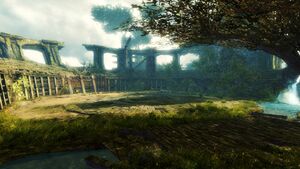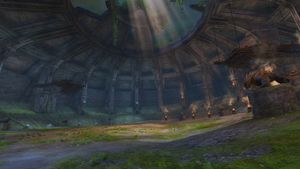Guild vs Guild
Guild vs Guild or GvG are player terms for a game format in which two guilds attempt to best each other in direct combat. Although the game mode is not directly supported in Guild Wars 2, a number of unofficial sites offer sets of rules and keep track of scores. Fights are typically held in the Mists Arena within Edge of the Mists. Formerly, the more popular location was the arena area in Obsidian Sanctum. After the Mists Arena received Team Change and Spectator Flags, the Obsidian Sanctum arena has become a less popular destination. They may also be held in a guild's Guild Arena, although the latter has become increasingly uncommon as PvE balance has diverged from WvW balance. Traditionally, matches feature even teams of 15 or 20 players on each side, though "Roster vs Roster" fights are not uncommon for unofficial matches, or "scrims". A guild has "won" a round when their opponents have surrendered or, more rarely, have all died; matches often require winning the best of three or five rounds, though many guilds enjoy playing out the full "set" of 7 or more rounds.
Community[edit]
Guilds involved in GvGs tend to be comprised of a tight-knit group of players, as the community is fairly small, yet dedicated. Players are generally also World versus World players, though PvP-exclusive players participating is not uncommon. GvG guilds tend to have fixed raid schedules, coordinated builds, and merit-based ranking systems.
Most GvG guilds require members to be level 80, and to have exotic (or even ascended) quality gear with specific stat-lines following their guild's GvG meta. The GvG meta usually differs only slightly from the general WvW meta, but drastically from the general PvE meta. This may make the requirements to join rather steep for players that primarily play PvE due to the need for additional sets of armor and weapons.
Rivalries between GvG guilds are common and encouraged, to a point. Guilds that are particularly toxic have been known to encounter boycotts in both scrimmages and matches.
Tournaments[edit]
Usually once or twice a year, both the North American and European GvG communities independently hold tournaments to crown a "King of NA" and "King of EU" respectively. Held in almost always either a Swiss or Single Elimination format, these tournaments tend to encourage newer or less-experienced guilds to be more active in the scene, in hopes of receiving a cut of the community raised prize money. In addition, depending on the size of the tournament, there have been associated Gem giveaways for viewers as well, normally in the form of redeemable codes. Notably, the "Tier 2 2015 GvG Invitational" received gem codes directly from ArenaNet to help supplement the prize and giveaway pools.
History[edit]
As the GvG and WvW communities have historically made an effort to refrain from involvement on the Official Forums, much of the rich history of GvG hasn't been well-recorded. Most iterations of GvG and WvW specific community forums have been lost over the years, to the point where questions in regards to "who was the best guild at this specific point in time" can only be answered by members of the guilds themselves. While it is possible for a small subset of players to record what they remember since the game's launch in 2012, there has never been a unified effort to create an anthology of any kind.
Other terms[edit]
- Prior to the introduction of Raid content in 2015, the term raid generally referred to WvW and GvG guilds playing the mode as a singular group, usually looking around each map for other GvG guilds to fight.
- Scrimmage or scrim are practice matches between two opposing groups. While all GvG standings are community-maintained and non-comprehensive, results of these practice sessions are not factored into the 'ratings' for each guild. Scrimmages tend to be held in secluded locations of various Borderlands, historically on the flat area next to the windmill near Hero's Orchard (not necessarily on Green Borderlands); or on "Zerg Island", the colloquial name for the flat area north of the bridge to the southernmost Resource camp on Alpine Borderlands. This is done to avoid confusion with formal matches. Scrimmages are often held between a more organized or skilled guild and a lesser one, for the purposes of both groups improving from the practice rounds. Thus, they are rarely streamed.
- GvG Streamers Association or GSA is a group of members of the GvG community that regularly stream WvW and GvG related content, usually on Twitch. It is an unspoken rule to not block the view of anyone representing the GSA guild.
- Driver, Pin, Tag, or sometimes Dorito refers to the player that is the Commander of the group. Similar to World vs World, the guild's driver controls movement and target calling, usually through a separate voice program (such as Discord). They also usually coordinate with the opposing driver on when each round starts and stops. In most cases, the guild leader is also the driver, though some guilds may treat these as two separate positions, especially if the GvG players of a guild are a subset of a much larger guild, where a specific GvG driver is chosen instead. Most guilds tend to only have one main GvG Driver as part of the guild's identity; it isn't uncommon for guilds to change names when a new driver takes over.
- 15v15, 20v20, or RvR refer to the maximum number of players allowed on each side, where a "Roster vs Roster" allows for an imbalance of players either as a handicap or in efforts to allow the most guild members on each side to participate.
External links[edit]
- Kings of the Mist — a player-organized GvG tournament held during fall of 2014.

